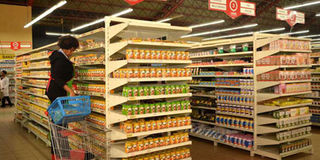Spending on campaigns and imports has caused high prices

A shop assistant arranges products on shelves at Uchumi Ngong Hyper in Nairobi. PHOTO | SALATON NJAU | NATION MEDIA GROUP
What you need to know:
The natural recourse to manage the situation is to mop excess cash in the economy through the open market by the Central Bank of Kenya.
However, this might be counterproductive given it will raise interest rates and further weaken the currency.
The other option is fiscal austerity to minimise money pumped into the economy by government spending.
Though this will slow down growth, it might just work.
Last October, I joined a door-to-door evangelistic mission trip to Makueni. In my company was a young man who had just graduated from the University of Nairobi with a degree in economics and statistics.
In one of the homesteads, we met an old woman who asked what we do. My young colleague thought it unwise to bundle his colourful achievements in one statement and instead took time to explain that he was an economist and that among other things, his job was to measure the GDP.
In frail voice, the old woman asked him: “GDP niki?” (what is GDP)? He had some difficulty explaining to her satisfactorily, the old woman said that she did not care about the new tricks the government had come up with now called njindipii. All she knew was that everything had become too expensive. She went ahead to tell us more about the good old days when fare to Nailovi was Sh10!
Earlier this week, The Kenya National Bureau of Statistics released the inflation figures for February, which showed that inflation rose to 9.4 per cent from 6.99 per cent in January. What this means is that your plate of food just got more expensive.
In October when the old woman was speaking, inflation stood at 6.47. If she was complaining then, God knows what she is going through now!
POPULAR JOKE
At a few retail outlets, a 2kg packet of maize flour is now Sh126.80, up from Sh119.60 the previous month. The popular joke in town across my peerage is that wheat flour is cheaper, yet when we were growing up chapati was rare because wheat flour was more expensive. On the same breadth, sukuma wiki is now more costly. That means that your plate of ugali sukuma just got more expensive.
But what is causing this increase in prices?
First, food is being imported because of the drought. This makes food more expensive. But it also worsens the balance of payments and further erodes the shilling. The result of a weak shilling is that it has lower buying power.
On the other hand, Kenyan elections have a way of pushing inflation high because leaders bribe voters.
Besides this informal spending by politicians, the electoral commission is going to spend about Sh31 billion to finance the August election.
Second, election spending for presidential aspirants is now capped at Sh12.5 billion each. Assuming there are only two candidates, the presidential campaigns will spend close to Sh25 billion. The average expenditure allowed for governors, senators and woman representatives is about Sh80 million each. Assuming two candidates per county, these campaigns will reach Sh22.5 billion. The member for national assembly average expenditure is Sh10 million while the member for county assembly average comes to Sh2 million. Assuming three candidates each, that amount get to Sh11.9 billion.
CIVIC EDUCATION
It would be right to say that in total the civic society’s expenditure, electoral body’s expenditure and the candidates’ campaign expenditure will push the spend in this election to Sh100.7 billion. Yet it should be remembered that these are conservative figures considering the fact that campaigns begin long before the expenditure is monitored by the electoral commission and candidates start spending from as early as a year before elections.
It is widely known that campaigns began late January with the clamour for voter registration. As such, we can conclude that the election spend is pushing inflation up.
Inflation is being caused by election spending and the drought.
The drought will ease only after the first harvest in June or July. But that also depends on whether the country will receive enough rain this year. On the other hand, election spending is here with us until August and might spill over to September in case of a run off. In principle, the prices of goods will continue to rise in the foreseeable future.
The natural recourse to manage the situation is to mop excess cash in the economy through the open market by the Central Bank of Kenya. However, this might be counterproductive given it will raise interest rates and further weaken the currency. The other option is fiscal austerity to minimise money pumped into the economy by government spending. Though this will slow down growth, it might just work.
Odhiambo Ramogi is chief executive officer, Elim Capital.




